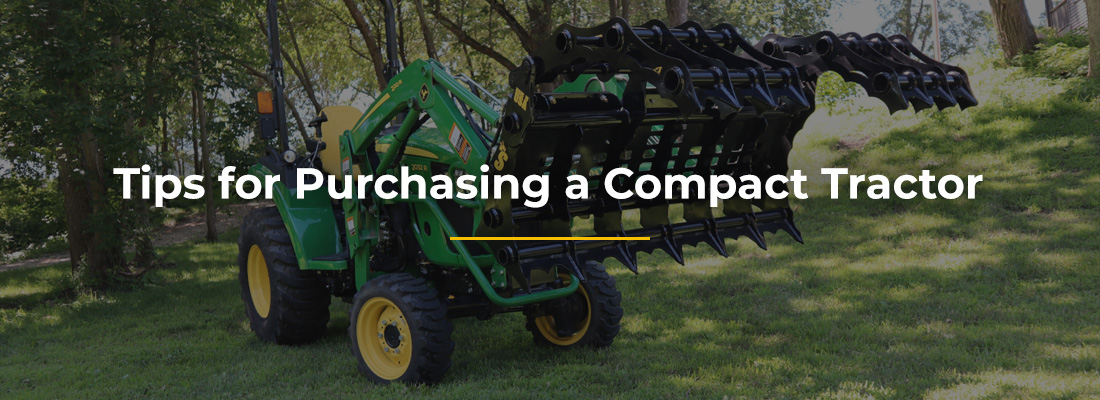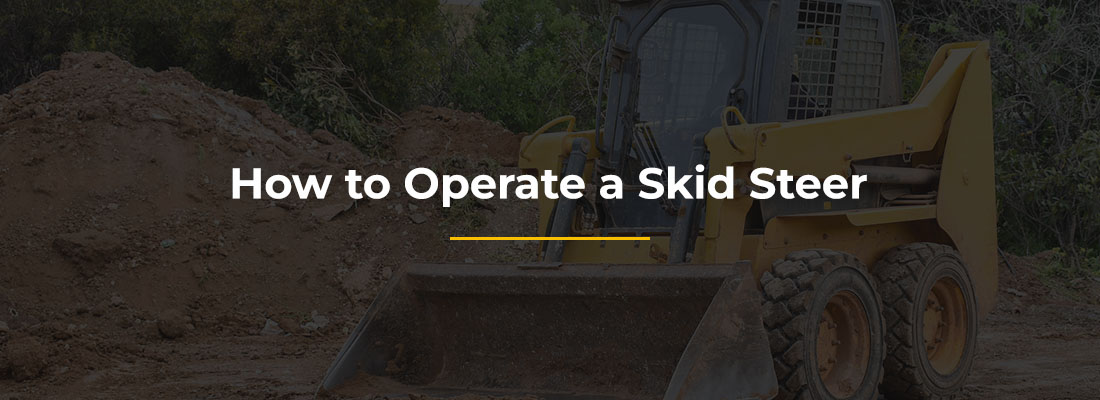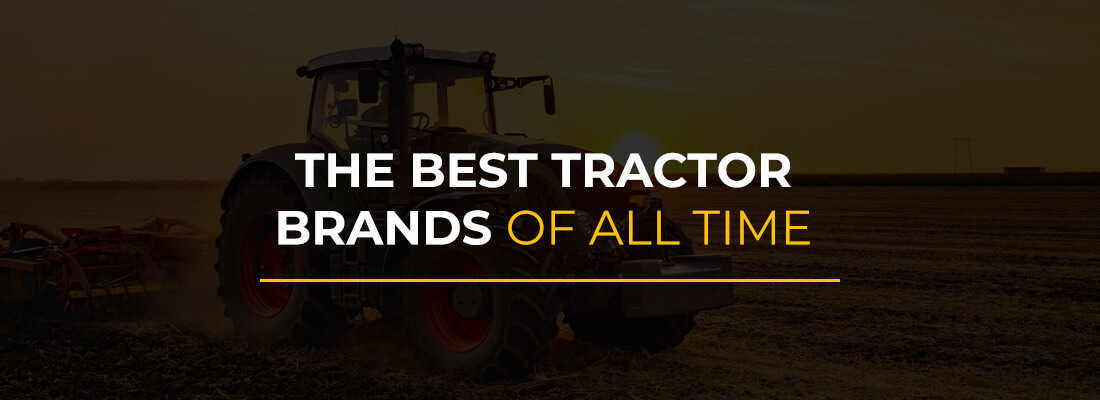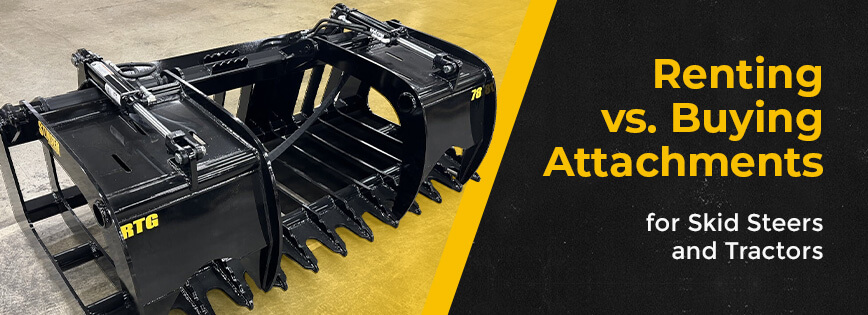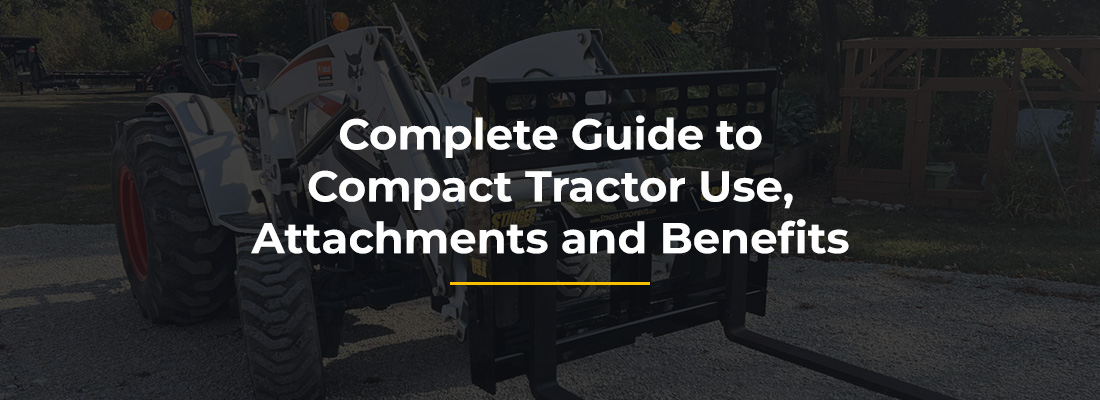Choosing the Right Skid Steers and Attachments for You
The availability of modern compact construction equipment has revolutionized many industries with its convenient size, impressive lifting capacities and improved fuel economy. If you’re shopping for compact construction and landscaping equipment, you’re probably considering a skid steer loader. Skid steers are extremely popular compact loaders designed for quick, efficient and versatile labor, making them top-selling equipment worldwide.
Skid steers range in size from small to large, and many are rated for surprisingly high load capacities. But what makes skid steers so in-demand is the numerous attachments they’re compatible with. No matter your industry or application, there’s a right skid steer attachment for you.
Factors to Consider When Choosing the Right Skid Steer
Not all skid steer loaders are created equal. When choosing a skid steer, there are several factors to consider so you can select the ideal model for your needs. Before purchasing a skid steer, it’s important to understand how you’ll be using it and where you’ll be using it. Consider the type of terrain conditions you’ll be working in and the kinds of materials you deal with. You’ll also want to research what other business owners and contractors in your field have to say about compact equipment options and whether they prefer certain features over others.
To get started finding the right skid steer for you, here are the top factors to consider:
1. Application
The first factor to consider when choosing a skid steer is the primary application it will be used for. Skid steers are employed across many industries, including:
- Construction
- Landscaping
- Farming and agriculture
- Forestry and logging
- Mining, oil and gas
- Logistics and supply chain
There are many ways to use a skid steer, from basic hauling and lifting to specialty uses, like pallet moving, vegetation management, rock breaking, demolition, snow removal and more. Here are a few common skid steer applications across industries:
- Lot clearing: Skid steer loaders are reliable in site preparation. With a variety of attachments, they can be put to use removing trees and shrubs, hauling away debris and grading and leveling lots.
- Digging and backfilling: Skid steer attachments give operators the ability to dig holes for tree plantings, fence posts and foundations, as well as backfilling to compact ground and reinforce built structures.
- Material handling: No matter the work site, you constantly need to move supplies and materials around safely and efficiently. Whether it’s with a bucket or grapple attachment, skid steers are the ideal small space material handlers.
- Cleanup and debris removal: Quickly haul away demolished building materials, brush and rock with a skid steer. A variety of attachments can help you get rid of debris and make site cleanup easy.
Some skid steers are better suited to the above application based on their size, capacity and horsepower, as well as their compatibility with the required attachments.
2. Size, Capacity, and Horsepower
Once you’re able to define the scope of applications you’ll have, the next factor to consider is size and capacity. Generally, skid steers are sized by the frame type — small, medium or large.
Each frame size can support a rated operating capacity (ROC) within a certain range based on classifications by the Associated Equipment Manufacturers. The ROC is the amount of weight the machine can lift before tipping, which is why you’ll sometimes see manufacturers call this rating the “tipping load.” The amount of horsepower the machine has is also limited by its size.
Here’s an overview of each size of skid steer and its capacities, horsepower and applications:
- Small-frame skid steers: Small-frame skid steers generally have an ROC of up to 1,750 pounds and under 50 horsepower. Ideal for residential work, small-frame skid steers are suitable for landscaping, construction and demolition work in small spaces.
- Medium-frame skid steers: Medium-frame skid steers have an ROC of between 1,750 and 2,200 pounds and horsepower between 50 and 70. With more power, a medium-frame skid steer may be more suitable for commercial construction or tougher demolition jobs where space constraints aren’t as much of a concern.
- Large-frame skid steers: Large-frame skid steers are classified as any machine rated for an operating capacity of 2,200 pounds and over. They also have a horsepower of more than 70. When dealing with large and heavy items or high speed and power needs, choose a large-frame skid steer for maximum productivity.
It’s important to consult a construction equipment specialist who can recommend the right size of skid steer for your needs.
3. Lift Type
Size and capacity are not the only way to categorize skid steers. Many business owners and contractors shopping for skid steers also assess their options by lift style. Many skid steer manufacturers offer machines with either a radial or a vertical lift, each being useful for a specific set of applications.
Here is a comparison between vertical and radial lifts in skid steer loaders:
- Vertical lift: Skid steers with vertical lifts are designed to help you access high and hard-to-reach spaces. Through its lift cycle, a vertical lift skid steer achieves maximum reach, or forward extension, at its midpoint compared to radial lifts. Vertical lift skid steers are often used in warehouses, building supply yards and for other material handling purposes.
- Radial lift: Rather than lifting straight up and down, the radial lift extends outward, achieving maximum reach closer to the ground. Considering this design, radial lift skid steers are better suited for digging, backfilling, mowing, lot clearing and other similar jobs.
It’s not always clear which lift type is the better investment, especially in construction and farming, where you may need your skid steer to tackle a variety of aerial and ground jobs. In this case, either option is probably fine since you won’t be performing one type of job more often than another.
4. Tracks vs. Wheels
Choosing the right skid steer also requires you to consider the ground conditions you operate in. Whether you work on flat and hard ground or you operate in rugged and uneven terrain, you can select between tracks and wheels. Here’s a look at the difference between tracks vs. wheels on skid steers:
- Tracks: Tracked skid steers are designed to operate on difficult terrain. With tracks, the machine is able to distribute its weight over a larger surface area, helping it to glide over ground that would otherwise cause a wheeled vehicle to get stuck. Tracks are a good idea if you’re using your skid steer on a farm and want to protect the soil, or you’re developing a rugged or muddy lot.
- Wheels: Skid steers typically come equipped with rugged wheels that allow you to move around quickly. When you don’t need the extra traction, such as when working in a supply yard or storage facility or maneuvering a flat lot, wheels are your better option. Skid steers with wheels require less frequent maintenance and part replacements than tracks.
5. Controls
The type of controls you prefer typically determines which age range of skid steer model you should look for. Older skid steers were designed with levers and pedals, which is the conventional control method many operators are used to and feel comfortable with. Because a lever and pedal control system is more hands-on, it allows operators to intuit how much power they’re applying.
Modern skid steers across a range of manufacturers now come with joystick controls, which are typically considered safer and easier to operate. For this reason, many employers choose to purchase skid steers with joystick controls because it may reduce the risk of workplace incidents among operators. Typically, joystick controls will have the ISO control pattern, where the left joystick drives the machine, and the right joystick controls the boom and bucket.
Control type boils down to personal preference, so test-drive a few models to find the one that’s most comfortable for you.
6. Manufacturer
Choosing the right model of skid steer for your application may depend on the manufacturer and whether it produces the right option for your needs. Here is a breakdown of some of the leading skid steer manufacturers and their specialties:
- ASV — American manufacturer of medium- and large-frame skid steers with radial or vertical lifts.
- Bobcat — American company specializing in small-frame, vertical-lift skid steers.
- CASE — American manufacturer of small-frame vertical- and radial-lift skid steers.
- Caterpillar — American manufacturer of small-, medium- and large-frame vertical-lift skid steers.
- JCB — British manufacturer of small- and medium-sized vertical-lift and telescoping boom skid steers.
- John Deere — American manufacturer of small-, medium- and large-frame skid steers with both vertical and radial lifts.
- Kubota — Japanese manufacturer of medium- and large-frame vertical-lift skid steers.
- Vermeer — American manufacturer of mini ride-on skid steers.
- Volvo — German manufacturer of small-, medium- and large-frame radial- and vertical-lift skid steers.
With the ability to rent skid steers today, you have access to a wide variety of manufacturers to test out before you commit to purchasing a skid steer. When choosing a manufacturer, always consider their level of quality assurance. Ask them about their warranty on skid steer equipment and how it applies to your purchase.
7. Attachment Compatibility
One of the reasons business owners and contractors gravitate toward skid steers of any variety or manufacturer is because of the incredible flexibility you get with their attachments. When choosing the right skid steer, consider the types of attachments you’ll want to use regularly to perform your work.
In most cases, modern skid steers are compatible with every attachment, provided they meet certain requirements. Thanks to universal coupling design, newer skid steers have very few limitations as to which attachments they can carry. If you buy a fairly old used machine, the coupling system might restrict its attachment compatibility.
Besides age, size and operating capacity are two additional factors that determine which type of attachments you can use with your skid steer. Another major consideration is the hydraulic flow. The hydraulic system of your skid steer needs to match the requirements of the attachment for the tool to function optimally.
Choosing the Right Skid Steer Attachments
Once you have the right skid steer picked out, it’s time to get it equipped with the right tools for your application. From material loading and handling to land management to debris and snow removal, skid steers can accomplish endless jobs when the right skid steer attachments are involved.
Below are some of the most popular skid steer attachments depending on the application you need:
Material Handling Attachments
Skid steers are compact material handling machines designed to help you quickly and efficiently load, haul and handle a variety of supplies and materials. With their front loader that can be outfitted with numerous specialty attachments, operators can easily carry around loose materials, large and heavy items or even palletized goods. They’re good on a construction site for hauling soil and supplies or in a warehouse for handling stock.
Stinger Attachments provides high-quality material handling attachments for your skid steer, including:
- Buckets
- Pallet forks
- Grapples
- Bale spears
Site Preparation and Lot Clearing Attachments
Site preparation is the very first heavy-duty job that needs to be done on construction sites. Contractors need versatile tools to help them quickly clear vegetation and remove boulders and rock. Skid steers can help you easily pop stumps, cut away thick brush and haul debris in preparation for construction.
Some of the key site prep attachments you may need for your skid steer include:
- Hammers and augers
- Stump grinders, brushcutters, mowers and mulchers
- Blades, rakes and land planes
- Buckets and grapples
For reliable site preparation tools, choose Stinger Attachments skid steer products, like rock grapples, root rock grapples and rock buckets.
Grading and Backfilling Attachments
Grading and backfilling small lots is easy with a skid steer and the right attachments. Whether you need to fill in holes, even out terrain or reinforce foundations and other structures, a variety of skid steer attachments can help you get the job done. If you just need to smooth out dirt, a bucket can help. If you need more precise leveling, a specialty raking tool is your best bet.
Here are a few of the essential grading and backfilling attachments for skid steers:
- Material and tooth buckets
- Blades and rakes
- Land planes
Outfit your skid steer with top grading and backfilling attachments from Stinger Attachments. Browse our material buckets, tooth buckets and land planes.
Digging and Trenching Attachments
A skid steer helps you tackle digging jobs of all types. Whether you need to dig post holes for fences and tree plantings or carve out a foundation or pool, skid steers can help you bite into hard, rocky soil. If you need to build smooth, even ditches for drainage or for laying irrigation lines or utility pipes, a skid steer is compatible with the right tools to get these tough jobs done.
Below are your must-have digging and trenching attachments for skid steers:
- Buckets
- Augers
- Trenchers
- Saws
- Backhoe arms
With augers and trenchers from Stinger Attachments, you can turn your skid steer into a digging and excavating machine.
Land Management Attachments
Land and vegetation management requires powerful and heavy-duty tools that can withstand dense brush and strong trees. If you’re a landscape contractor, you need a variety of tools to clear away brush and maintain pristine lawns. For private property owners and farmers, you need tools that will help you maintain easements and right-of-ways and cut back overgrowth along property lines and around structures.
To get these jobs done productively, here are a few of the land management skid steer attachments you might need:
- Brushcutters
- Flail mowers
- Stump grinders
- Tree pullers
Stinger Attachments provides a heavy-duty tree puller attachment that powerfully grabs and removes brush, stumps and more.
Soil Care Attachments
Taking care of topsoil is a vital practice in farming and landscaping. To sift through old and rocky dirt or condition fallow land, you need the most efficient tools for the job. With a variety of skid steer attachments for soil conditioning, farmers, landscapers and property owners can give their soil the boost it needs in preparation for planting, seeding or sod laying. You can also use landscape attachments to help you mix compost or fertilizer into the soil, saving you hours of manual labor.
To ensure your soil is as healthy as possible, choose soil care attachments such as:
- Land planers
- Landscape rakes
- Soil tillers
- Soil conditioners
- Seeders
The mini soil conditioner attachment from Stinger Attachments is the ideal multipurpose tool. With a single attachment, you can grade, rake and pulverize, as well as remove debris ahead of planting.
Snow Removal Attachments
If you operate your business in a winter climate with snow, you need the right seasonal tools to help you stay productive year-long. Snow removal attachments for skid steers are convenient and hard-working tools that efficiently remove and pile away snow so you can get back to work. Many snow removal attachments can also be put to use in the fall for clearing away light loads, like leaves and brush.
There are many snow attachments to choose from, including:
- Snow buckets
- Snow plows or blades
- Snow pushers
- Snow blowers
Snow removal attachments from Stinger Attachments help you keep on top of winter weather. A snow bucket allows you to scoop up and remove snow completely, while a snow pusher gives you the power to pile it away.
Cleanup and Sweeping Attachments
Keeping a work site neat and tidy is essential to a productive project. Skid steer brooms and sweepers turn your workhorse machine into the cleanup tool you need. Two types of skid steer broom attachments can help you get debris, dirt and mud under control.
Angle brooms allow you to clean up dirt and dust with precision because you can angle the head along edges and in corners. They’re ideal for parking lot and private property maintenance. Pickup brooms are equipped with an attached hopper to contain the debris for easy disposal later. Use pickup brooms on construction sites or for landscaping jobs.
Stinger Attachments manufactures both angle brooms and pickup brooms for your skid steer loader.
Choose Stinger Attachments for Skid Steer Attachments
Skid steers are a great investment for any construction and landscaping business owner, farmer or landowner. Their compact size makes them convenient to handle, and their range of compatible attachments gives them unsurpassable versatility. They’re the ideal all-in-one machine that work sites can’t afford to go without.
When you need durable and versatile attachments for your skid steer, choose Stinger Attachments. We offer superior quality and design on all our manufactured skid steer attachments for industrial, construction, landscaping and forestry applications. Find the best tools to make your job easier and more productive by browsing our line of skid steer attachments. Contact us online today or call 507-273-7497 for more information on our products and prices.

